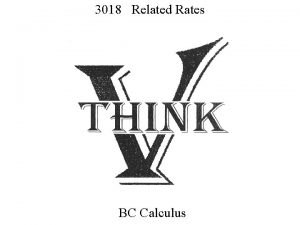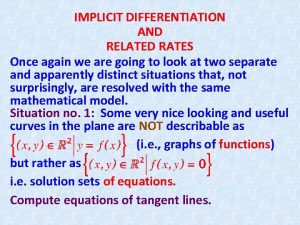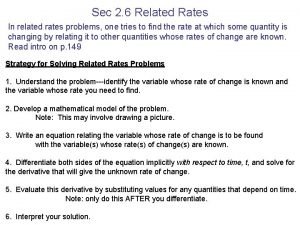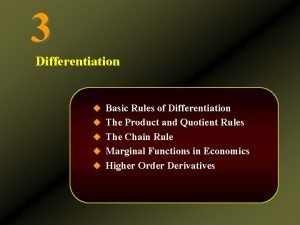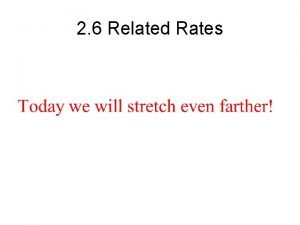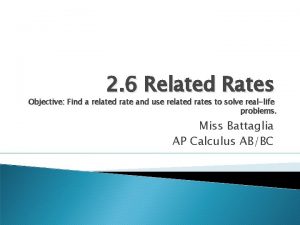RELATED RATES RELATED RATES v If we are














- Slides: 14

RELATED RATES

RELATED RATES v. If we are pumping air into a balloon, both the volume and the radius of the balloon are increasing and their rates of increase are related to each other. n However, it is much easier to measure directly the rate of increase of the volume than the rate of increase of the radius. 2. 7 P 2

RELATED RATES v. In a related-rates problem, the idea is to compute the rate of change of one quantity in terms of the rate of change of another quantity (which may be more easily measured). n The procedure is to find an equation that relates the two quantities and then use the Chain Rule to differentiate both sides with respect to time. 2. 7 P 3

Example 1 v. Air is being pumped into a spherical balloon so that its volume increases at a rate of 100 cm 3/s. v. How fast is the radius of the balloon increasing when the diameter is 50 cm? 2. 7 P 4

Example 1 SOLUTION v. We start by identifying two things: n n Given information: The rate of increase of the volume of air is 100 cm 3/s. Unknown: The rate of increase of the radius when the diameter is 50 cm. v. To express these quantities mathematically, we introduce some suggestive notation: n Let V be the volume of the balloon and let r be its radius. 2. 7 P 5

Example 1 SOLUTION v. The key thing to remember is that rates of change are derivatives. n n n In this problem, the volume and the radius are both functions of the time t. The rate of increase of the volume with respect to time is the derivative d. V / dt. The rate of increase of the radius is dr / dt. 2. 7 P 6

Example 1 SOLUTION v. Thus, we can restate the given and the unknown as follows: n Given: n Unknown: 2. 7 P 7

Example 1 SOLUTION v. To connect d. V / dt and dr / dt, first we relate V and r by the formula for the volume of a sphere: v. To use the given information, we differentiate each side of the equation with respect to t. n To differentiate the right side, we need to use the Chain Rule: 2. 7 P 8

Example 1 SOLUTION v. Now, we solve for the unknown quantity: n n If we put r = 25 and d. V / dt = 100 in this equation, we obtain: The radius of the balloon is increasing at the rate of 1/(25 p) cm/s. 2. 7 P 9

Example 2 v. A ladder 10 ft long rests against a vertical wall. If the bottom of the ladder slides away from the wall at a rate of 1 ft/s, how fast is the top of the ladder sliding down the wall when the bottom of the ladder is 6 ft from the wall? 2. 7 P 10

Example 2 SOLUTION v. We first draw a diagram and label it as in Figure 1. n n Let x feet be the distance from the bottom of the ladder to the wall and y feet the distance from the top of the ladder to the ground. Note that x and y are both functions of t (time, measured in seconds). 2. 7 P 11

Example 2 SOLUTION v. We are given that dx / dt = 1 ft/s and we are asked to find dy / dt when x = 6 ft. v. See Figure 2. 7 P 12

Example 2 SOLUTION v. In this problem, the relationship between x and y is given by the Pythagorean Theorem: x 2 + y 2 = 100 v. Differentiating each side with respect to t using the Chain Rule, we have: n Solving this equation for the desired rate, we obtain: 2. 7 P 13

Example 2 SOLUTION v. When x = 6 , the Pythagorean Theorem gives y = 8 and so, substituting these values and dx / dt = 1, we have: n n The fact that dy / dt is negative means that the distance from the top of the ladder to the ground is decreasing at a rate of ¾ ft/s. That is, the top of the ladder is sliding down the wall at a rate of ¾ ft/s. 2. 7 P 14
 Mikael ferm
Mikael ferm Ratios rates and unit rates
Ratios rates and unit rates Is a ratio a rate
Is a ratio a rate Equivalent ratios guided notes
Equivalent ratios guided notes Ratios rates and unit rates
Ratios rates and unit rates Related rates intro
Related rates intro One leg
One leg Implicit differentiation and related rates
Implicit differentiation and related rates Rate of change of hypotenuse
Rate of change of hypotenuse Solve
Solve Related rates baseball diamond
Related rates baseball diamond Related rates
Related rates Two types of fitness components
Two types of fitness components Example of skill-related fitness
Example of skill-related fitness Ntuc incomeshield premium rates
Ntuc incomeshield premium rates






